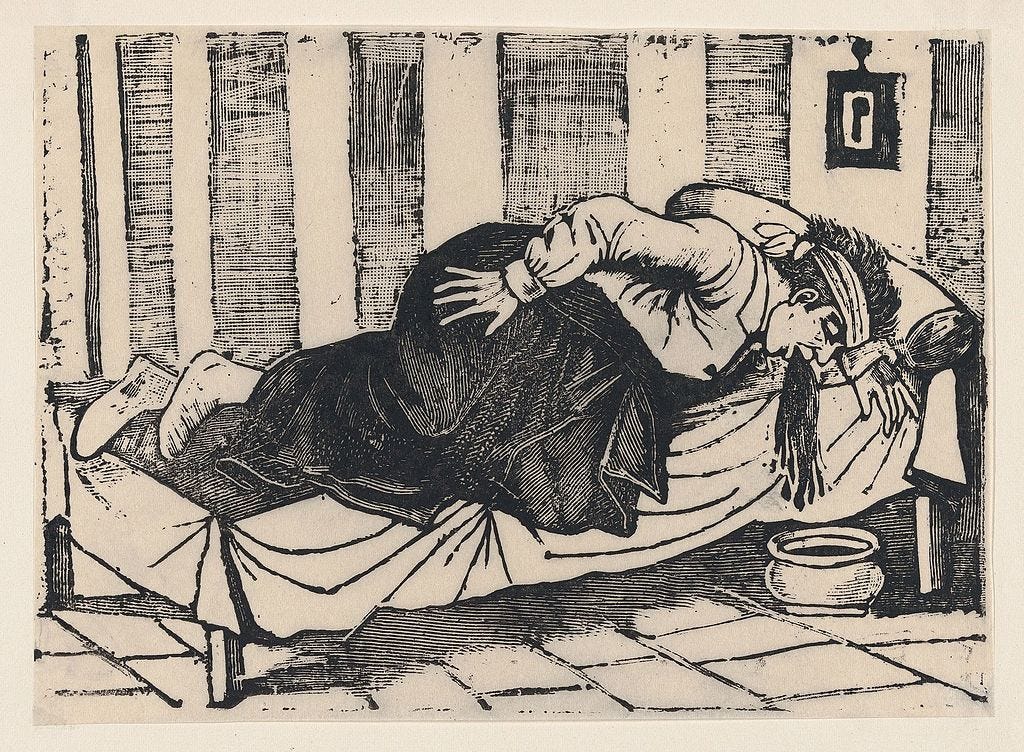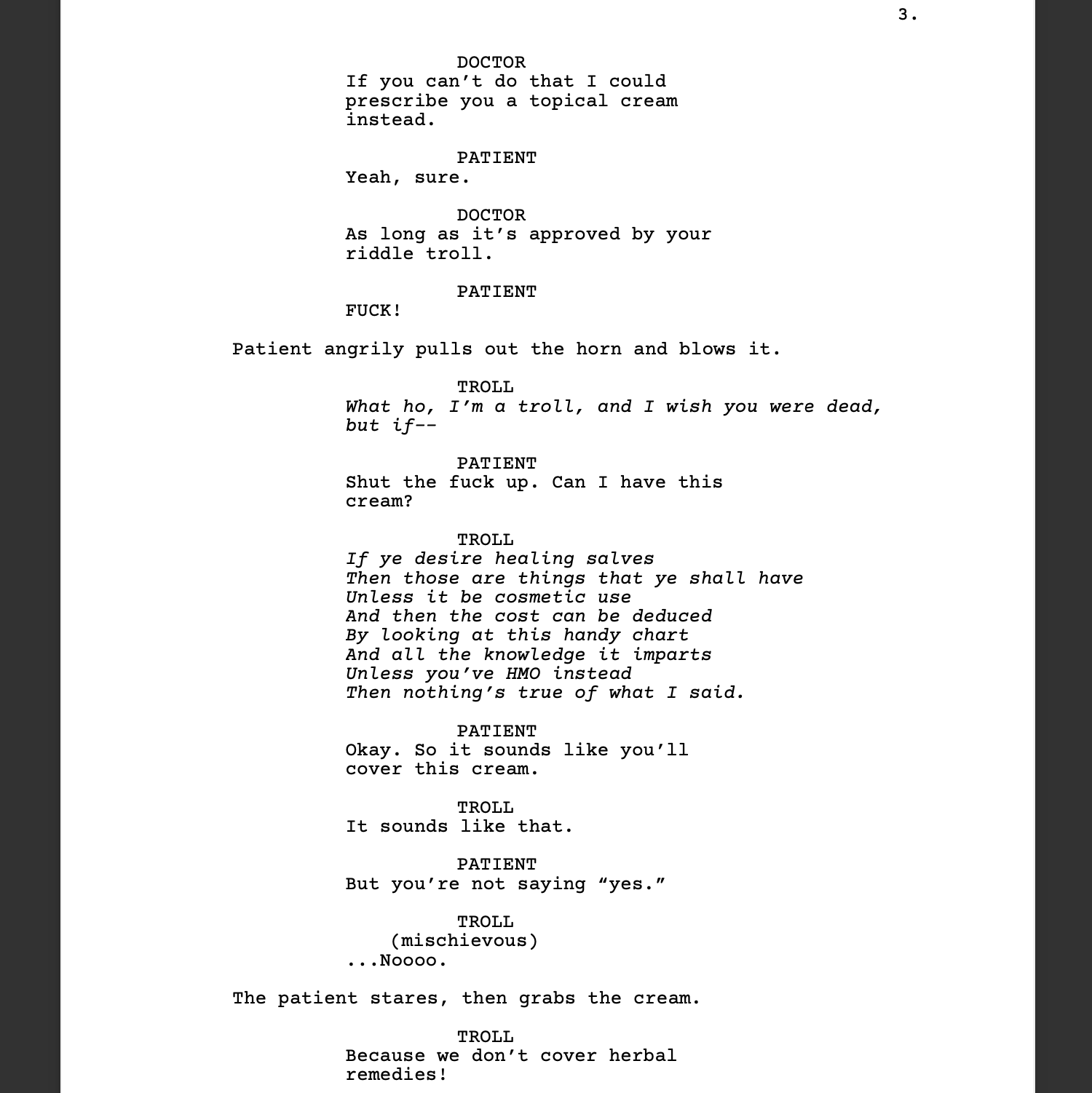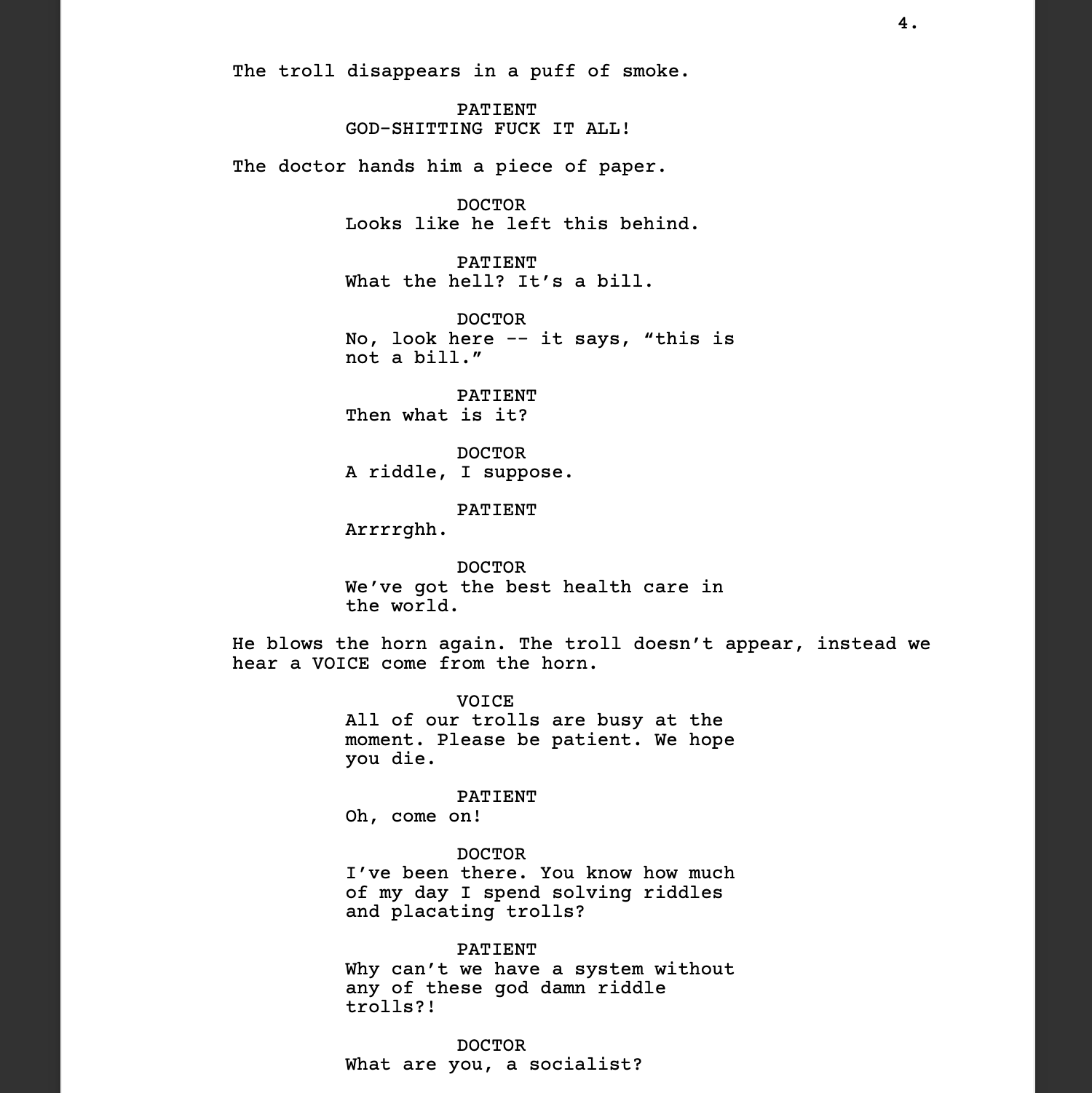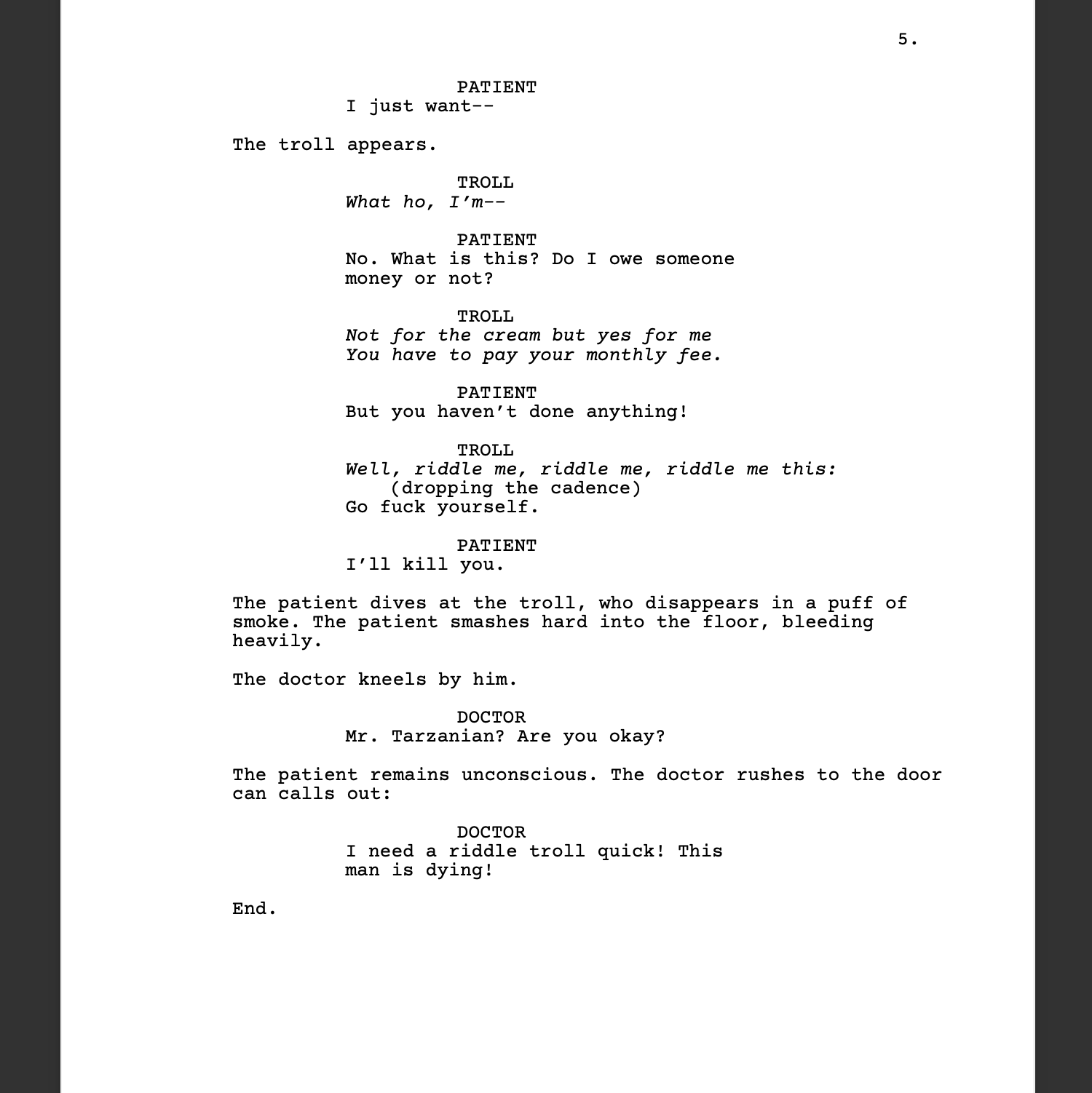Hey! It’s time to get writing! If you’ve been following along with the process posts then you’ve already done a lot of work. You’ve got an understanding of how sketches work and what makes a game funny. You should have at least a few sketch ideas, and an outline (or at least a brainstorm sheet) for an idea you like. You have everything you need to start the script.
For some people this is the toughest hurdle to overcome — it’s one thing to have disconnected jokes and ideas, but how do you turn that into a coherent script? The good news is you’ve already done a lot of the creative heavy lifting. Writing the rough draft is more of a psychological hurdle. But you can get over it!
It helps to be in the right frame of mind. Have fun with it. If you’re having a good time while you’re writing, it’s likelier that people will have a good time watching the finished sketch. Surprise yourself. Get silly. Your sketch has a game — play it.
The Vomit Draft
Easy for me to say, right? I’ve done this a million times. Perhaps you’re looking at the big blank page and not feeling in a very playful mood. Maybe you feel lost and confused. How do you even begin?
In my post about coming up with ideas I talked about separating the generative mind from the critical mind. You want to do the same thing here. Lock up the part of your brain that says “hey, what you just wrote sucks” and unleash the part of your brain that says “and then this happens!” Write the vomit draft.
Some people hate this term because it’s gross. I like it because it’s accurate and stupid (just the way I like all my comedy). This draft is a horrible geyser of words that erupts out of you quickly and messily. And, like vomiting, the result is ugly, but you’ll feel better when it’s done. The goal with a vomit draft is to get words out as fast as possible without getting in your own way. Write a beat, figure out how the characters would naturally react, then add the next beat. Go as fast as possible.
If you’re not sure how to start, skip all the scene setting and go immediately to the first beat. This is often the the first thing you thought of when you came up with the idea. You know that part is funny, so you might as well start with a sure thing. You can add whatever contextual lines you need later.
Not sure how to connect one beat to the next? Skip it! Jump abruptly to the next beat. Fix it later. Know you need a joke, but not sure what it is? Write “Add joke here,” and fix it later. Keep moving. Not sure what moment comes next? Look at your outline. You already came up with options. Worried that what you’re writing might be shitty? Don’t worry: it definitely is. Who cares? YOU CAN FIX IT LATER.
Your mantra for the vomit draft (in case it wasn’t glaringly obvious) is “you can fix it later.” But this isn’t procrastinating; you’re avoiding getting stuck on problems that may have obvious solutions by the end of the sketch. You’re feeling out the rhythm, tone, and structure of the whole piece. It’s like putting up the frame of the house before you start plastering the walls.1
Once you’ve finished your vomit draft, lock the generative brain away, and bring out the critical mind to examine what you’ve done.
The Rough Draft
And, oh my god, what have you done?! You’ve written a real mess… but I bet it looks a lot like a sketch. There are some holes and some bits that don’t totally fit together, but you’ve got completed pages! You just have to polish them up now. The goal with the rough draft is to have a draft that’s good enough to show someone you trust. It doesn’t have to be (and probably won’t be) perfect, so go ahead and take that pressure off yourself. Here are some things to check when you’re turning your vomit draft into a rough draft.
The Things You Know You Need to Fix: Remember all the things you said you’d fix later? Well, it’s now “later.”
Obvious Errors: Fix ‘em! This includes spelling errors, grammar errors, formatting, and consistency errors.
Long lines: Cut ‘em! Shorter lines are funnier.
Weird Beats: Does a beat feel like it takes too long to set up? Or like a de-heightening? You might need to move some beats around or cut some entirely.
Unintended Repetition: Are you repeating a specific word too much?
Word Choice: Do these sound like the words your characters would use?
Overall length: Are you under three pages? You may have time to squeeze more beats in. Over five? You’ll want to make cuts.
Joke punch up: Are all your jokes constructed in the tightest way possible? Are your set ups clear and your punchlines short? Do these jokes feel fresh and original? When in doubt, leave it in, but come up with an alternate.
Specifics: Specifics are funnier than vagaries. Make your generalities more precise.
Juxtapositions: Is the contrast between juxtaposed elements stark enough? Are the contrasting elements near enough to each other? Are you showing both halves of the juxtaposition equally?
Naturalism: Do your characters sound human? Are they behaving believably and playing to the top of their intelligence?
Consistent Game: Are you playing the same game throughout? Is your game clear? Will your audience be able to tell what your POV is, and how it relates to them?
This whole process will take some time, but you’ll get faster as you go. When I first started I would take a whole day, obsessively working over a single sketch. Now I can reliably plan to go from idea to finished rough in 2-4 hours. If you’ve never written a sketch before, I’d suggest blocking off one writing session for the vomit draft (1-3 hours) and one writing session for the rough (1-3 hours). You might not need all this time, but it at least gives you a plan. You might need more time, but if you do you may want to consider what’s slowing you down. Is there something with the idea you’re resisting? Or is there something about the writing process itself you’re finding psychologically daunting? Either way, there are solutions (albeit different ones).2
There’s also a cruel irony that good, clear sketches are much faster and easier to write than sketches with muddy, weak games. This means that a great sketch can be written in hours, while a bad sketch takes days. But don’t worry: even a subpar sketch can be salvaged with the right notes.
A New Sketch
To give you a real look at my process, I’ve written up a fresh, new, never-before-seen sketch. I’ve intentionally left this draft a little rougher than usual so you can watch this go through the notes process and follow along from the beginning. It’s somewhere between a vomit and a rough — I couldn’t resist fixing some things along the way, but I left in a few errors and things I know I want to change.
The Idea
This sketch grew out of a bit of frustration trying to deal with health insurance companies. Their rules are opaque, and the consequences for breaking them are dire, even life-threatening. It is absolutely insane to me that health care in the United States is centered around byzantine systems actively trying to deny you care. Maddening! Frustrating! And, like any emotional moment, a great inspiration for a sketch.
In fact, there’s already a natural juxtaposition of contrasts: a system that is supposed to care for people relies on companies that are incentivized to deny care. Is this enough for a sketch? Maybe. But it’s not a particularly novel observation. It’s also (sadly) not very exaggerated. But that core juxtaposition is worth exploiting. So how can we make it even more extreme? What does it remind me of?
When I deal with medical stuff, I feel like I’m being quizzed… but the stakes are my life. And this feels kind of like a fairy tale. A Rumpelstiltkin-like situation where a mercurial being of immense power toys with people for his own amusement. And now an idea starts to take shape…
What if we have a sketch where a magical riddle troll is a stand in for insurance companies. It’s a connection that is surprising, but has some truth to it. Both insurance companies and tricksters are powerful, confusing, and have no problem toying with your life. So what if we heighten the juxtaposition between care and harm with a doctor who cavalierly explains that medical care requires solving the puzzle of riddle troll. Ridiculous. Stupid. Absurd. And just a tiny bit true. That is how it feels to talk to insurance companies. Sounds like a good first beat to me! On to the brain storm!
The Brainstorm
This is what my brainstorm sheet looks like. It’s a mess. A bunch of unattributed lines, notes to myself, questions to myself, possible beats, and more, all mixed together. Some lines are just lists of terms. Not even jokes. It’s chaos, but it’s useful chaos. As I covered in my post about outlines, this is like a toy box — I’ll dig through here for the moment I want when I’m writing my script.
The Rough Draft
I started on a vomit draft with a different angle than the one I settled on. It was initially set in a world where the patient in the sketch had never dealt with a riddle troll before. I had thought this would make the connection between insurance and the troll a little more explicit, but I ran into a problem where the patient was only asking questions. The situation was too unfamiliar to him. This didn’t give him much of a point of view beyond “confused” and lead to a repetitive rhythm. And it seemed too unrealistic for him to just go along with the madness. So, about a page in, I abandoned that angle for a new one. In the version below we live in a world where people are very familiar with riddle trolls, they just hate them… y’know, like insurance companies.
You’ll notice some of the ideas from the brain storm made it into this draft, and others didn’t. Some of these were ideas I just didn’t like: is a physical challenge that interesting? Eh. Others were ideas I loved, but didn’t find a place to naturally fit it in: I love the particularly infuriating idea of the troll’s riddle being the very question you’re hoping to get answered. But it ain’t in here. And that’s fine for now. Maybe after a few rounds of notes I’ll change my mind. I still have those ideas saved in my brainstorm sheet. I think the sketch makes sense, even if it could use a bit more polishing.
How about that? A new sketch. There’s a lot I don’t like about this, but there are some things I do. And that’s pretty normal for a rough draft! In the coming weeks I’ll show you how this script continues to be reworked.
That’s all for this week! If you’re enjoying Chuffah please tell your friends. And if you’d like to comment, get a few extras, or support the newsletter to keep it mostly free, please consider a subscription (the annual plan is less than a dollar per week).
Exercises
I just did it, and you can too: write a draft from the outline you made a few weeks ago. If you’ve grown to hate it, try something new. Or push through and find an angle that works. No matter what you do, have fun!
I assume this is how you build a house. Please don’t ask any follow-up questions.
We’ll talk more about both in a later post.











I think I needed the word "vomit draft" in my head, to give me permission to rush some things (a lesson I learned from NaNoWriMo that apparently didn't jump from stories to scripts). I've sorta been editing my concept to death, starting over too much and a good vomit is probably just what the doctor ordered.
Also, rough draft or not I loved the script. Been rewatching a lot of 30 Rock lately so it was hard not to hear Dr. Spaceman's voice for some of those lines.
Also, you've talked about brainstorm and vomit drafts. But I feel like I've mostly been vomit drafting while brainstorming, thinking about a good beat or joke on the spot. In fact I first tried to brainstorm after your last post. It went well but I feel like the idea I had lent itself to brainstorming.
Is brainstorming as a single step really necessary ? Do you always do it ? Should I always try to do it in order to maximize the quality of my work ?